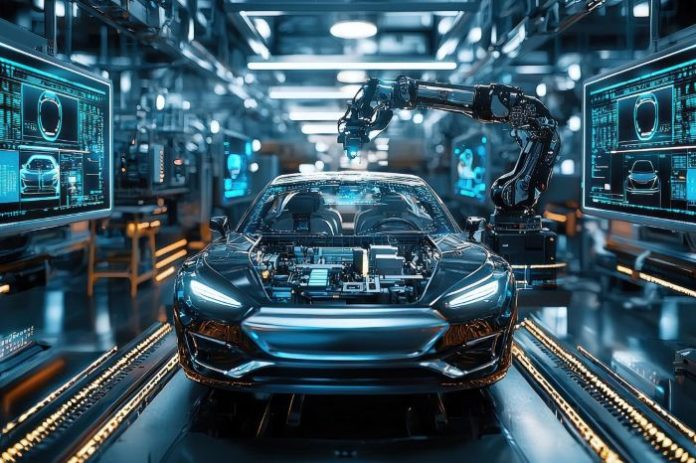Do you want to know what the automotive industry is talking about these days?
It’s not electric vehicles or improved batteries. The real game-changer is artificial intelligence.
And here’s the thing…
Automotive companies that are winning these days are not only using AI. They have scalable AI solutions that can grow with their needs.
In this article, we will cover:
- What Makes Scalable AI Solutions Different?
- The Automotive AI Revolution Is Here
- Manufacturing Gets Smarter With AI
- Autonomous Driving: The Ultimate Scale Challenge
- Predictive Maintenance Changes Everything
Table of contents
What Makes Scalable AI Solutions Different?
Scalable AI is not just having AI technology in your cars or factories.
Scalable AI solutions is about developing AI systems that can scale, adapt and improve without breaking the bank or requiring a complete redesign every time you want to add a new feature.
Think of it this way…
A car manufacturer may start by implementing AI for quality control on a single production line. But what if they want to expand it to 50 factories worldwide? That is where scalability comes into play.
The answer is: The automotive industry is advancing at an unprecedented pace. Automotive companies need AI systems that can handle increasing volumes of data, support new models of vehicles and integrate with existing infrastructure smoothly.
Scalable AI solutions are built to scale up with your needs, allowing automotive companies to start small and scale up their AI capabilities as they prove value. This minimizes risk and maximizes the return on investment.
Beautifully scaled AI systems become smarter over time. The more data it is fed, the better it gets at making predictions. The better it is at predictions, the more improved the performance is. And the better the performance, the more competitive an advantage.

The Automotive AI Revolution Is Here
Hold on to your seatbelts, because we have an interesting statistic to share with you. The AI automotive market is on fire. And we are not just exaggerating.
According to recent analysis, by 2025 15% of all new vehicles are projected to include some form of AI-based autonomous driving capabilities.
This is not where the big news ends.
By 2033, the global automotive AI market is projected to hit an astonishing $134.5 billion, with a compound annual growth rate of 37.4%.
No small numbers, right?
The industry is expected to enjoy exponential growth due to various factors, including:
- Increasing demand for safer vehicles
- Rising consumer expectations for in-car technology
- Regulatory pressure to reduce emissions
- Competition driving innovation at a never-before rate
Big manufacturers are not left behind in this race either. We have companies like Tesla, BMW, Mercedes-Benz and Toyota pouring billions into AI-based systems that are enhancing everything from the safety of the drivers to the efficiency of the manufacturing.
Manufacturing Gets Smarter With AI
AI is transforming the way vehicles are built. Factories that used to operate on the inflexible and non-programmable robots are now running on learning and adaptable systems that can update and optimize in real-time.
What does this mean?
It means shorter production times, fewer defects and massive cost savings. Automated quality control systems powered by AI are now able to inspect thousands of parts in a minute and discover defects that the human eye may overlook.
AI quality control systems use computer vision that can analyze the parts when they are being assembled. This means the system can detect and spot micro-cracks, alignment and material defects before they turn into problems. The more data it gets, the better it gets at detection.
Supply chain management is another area where AI-based scalable solutions are providing huge value. Manufacturers of vehicles deal with thousands of parts from hundreds of suppliers.
AI systems can:
- Predict supply chain disruptions in advance
- Optimize inventory levels across many facilities
- Detect quality issues from specific suppliers
- Automate reorder process
The outcome is that companies end up saving on costs by minimizing wastage, and also by preventing downtime which, in turn, keeps the production lines moving.
Autonomous Driving: The Ultimate Scale Challenge
One of the most complex AI challenges in automotive is autonomous driving.
It is no contest!
Driving a car without the presence of a human driver requires AI systems that can process large volumes of data from multiple sensors, make split-second decisions, and still ensure the safety of the passengers. All this, while adapting to the ever-changing and unpredictable road conditions.
The problem is:
Developing an autonomous driving system for one car is difficult enough. Now scale that technology to millions of vehicles being driven in different countries with different road conditions, weather conditions and road traffic rules. Guess how many times more difficult it is?
The scalability challenge of autonomous driving is what the automotive industry is talking about.
This is why scalable AI architecture is essential. Automobile companies need systems that can:
- Process sensor data from cameras, radar, LiDAR and other sources in real-time.
- Continuously learn from millions of driving scenarios.
- Remotely and securely update the vehicles software.
- Scale to handle edge cases not part of the original training data.
Automotive companies that are leading in this space know that autonomous driving is not a one-time project. It is an ongoing process of continuous improvement and refinement. And this requires scalable AI systems built from day one.
Predictive Maintenance Changes Everything
I am going to tell you one of the most underrated benefits of AI in automotive.
Predictive maintenance.
Scheduled maintenance in the automotive industry has always been dependent on time or mileage. Change oil every 5,000 miles. Brake pads change at 50,000 miles. However, here is what is not known to the public…
Every vehicle is unique. While some vehicles will require new brakes at 40,000 miles, another car could make it to 70,000 miles before changing the brakes. Driving conditions, the behaviour of the drivers and patterns of vehicle use also affect the wear and tear of the components.
AI is changing all these.
Cars, nowadays, are being fitted with IoT sensors that can collect data about all the systems on the vehicle. These sensors work round the clock, collecting data on every part of the vehicle. The data is then analysed by AI algorithms that can predict when a particular component is about to break, and this happens before it actually breaks down. As a result, this would allow for:
- Scheduled repair works to take place before break downs happen
- Less downtime in commercial vehicles
- Less maintenance costs in general
- Increased customer satisfaction
For fleet operators who are in charge of hundreds or thousands of vehicles, predictive maintenance based on scalable AI solutions can save them millions of dollars every year. Instead of conducting maintenance work that is not needed or breakdowns that come as a surprise, they will only service the vehicles when they are supposed to be.
Bringing It All Together
The automotive industry is at a point of no return. Companies that are not embracing scalable AI-based solutions these days will be left behind.
The numbers show this. With an AI automotive market growing at an annual rate of 37% and above, and AI affecting every facet of the industry from manufacturing to autonomous driving, there is no time to waste.
The beauty of scalable AI solutions is that they provide:
- Flexibility to start small and scale up strategically
- Cost-effective implementation that shows ROI quickly
- Systems that improve with more data
- Competitive advantages that increase as the systems get better
Whether you are building the next generation of electric vehicles or trying to optimize your manufacturing or working on autonomous driving technologies, scalable AI is the basis everything else is going to be built on.
Automotive companies that are leading the charge these days understand this, and that is why they are not just buying AI tools. They are developing scalable AI strategies that revamp their entire business. And you know the results they are getting, right?
The question is no longer whether you should be using AI for automotive applications. The question is whether you are building AI systems that can scale with your ambitions. Because in a field where time is moving as fast as it is moving in the automotive sector, the only way to be on top is to build systems that are designed to grow from day one.











